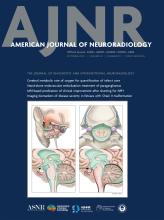Research ArticleArtificial Intelligence
DSA Quantitative Analysis and Predictive Modeling of Obliteration in Cerebral AVM following Stereotactic Radiosurgery
Mohamed Sobhi Jabal, Marwa A. Mohammed, Cody L. Nesvick, Hassan Kobeissi, Christopher S. Graffeo, Bruce E. Pollock and Waleed Brinjikji
American Journal of Neuroradiology October 2024, 45 (10) 1521-1527; DOI: https://doi.org/10.3174/ajnr.A8351
Mohamed Sobhi Jabal
aFrom the Department of Radiology (M.S.J., M.A.M., H.K., W.B.), Mayo Clinic, Rochester, Minnesota
bDepartment of Computer and Information Science (M.S.J.), University of Pennsylvania, Philadelphia, Pennsylvania
Marwa A. Mohammed
aFrom the Department of Radiology (M.S.J., M.A.M., H.K., W.B.), Mayo Clinic, Rochester, Minnesota
Cody L. Nesvick
cDepartment of Neurological Surgery (C.L.N., C.S.G., B.E.P., W.B.), Mayo Clinic, Rochester, Minnesota
Hassan Kobeissi
aFrom the Department of Radiology (M.S.J., M.A.M., H.K., W.B.), Mayo Clinic, Rochester, Minnesota
Christopher S. Graffeo
cDepartment of Neurological Surgery (C.L.N., C.S.G., B.E.P., W.B.), Mayo Clinic, Rochester, Minnesota
Bruce E. Pollock
cDepartment of Neurological Surgery (C.L.N., C.S.G., B.E.P., W.B.), Mayo Clinic, Rochester, Minnesota
Waleed Brinjikji
aFrom the Department of Radiology (M.S.J., M.A.M., H.K., W.B.), Mayo Clinic, Rochester, Minnesota
cDepartment of Neurological Surgery (C.L.N., C.S.G., B.E.P., W.B.), Mayo Clinic, Rochester, Minnesota

References
- 1.↵
- 2.↵
- 3.↵
- 4.↵
- 5.↵
- Karlsson B,
- Lindquist C,
- Steiner L
- 6.↵
- Hopewell JW,
- Millar WT,
- Lindquist C, et al
- 7.↵
- 8.↵
- 9.↵
- 10.↵
- Oppenheim C,
- Meder JF,
- Trystram D, et al
- 11.↵
- Steiner L,
- Lindquist C,
- Adler JR, et al
- 12.↵
- Derdeyn CP,
- Zipfel GJ,
- Albuquerque FC, et al
- 13.↵
- 14.↵
- 15.↵
- 16.↵
- 17.↵
- 18.↵
- 19.↵
- 20.↵
- 21.↵
- Neisius U,
- El-Rewaidy H,
- Nakamori S, et al
- 22.↵
- 23.↵
- 24.↵
- Tourassi GD
- 25.↵
- 26.↵
- Pollock BE,
- Flickinger JC,
- Lunsford LD, et al
- 27.↵
- Stapf C,
- Mast H,
- Sciacca RR, et al
- 28.↵
- 29.↵
- 30.↵
- 31.↵
- Lawton MT,
- Kim H,
- McCulloch CE, et al
- 32.↵
- 33.↵
- Fedorov A,
- Beichel R,
- Kalpathy-Cramer J, et al
- 34.↵
- 35.↵
- van Griethuysen JJM,
- Fedorov A,
- Parmar C, et al
- 36.↵
- 37.↵
- Peng H,
- Long F,
- Ding C
- 38.↵
- 39.↵
- Chawla NV,
- Bowyer KW,
- Hall LO, et al
- 40.↵
- Lundberg SM,
- Allen PG,
- Lee SI
- 41.↵
- 42.↵
- 43.↵
- 44.↵
- 45.↵
- 46.↵
- 47.↵
- 48.↵
- 49.↵
- Kleinbaum DG,
- Kupper LL,
- Muller KE
- 50.↵
- 51.↵
In this issue
American Journal of Neuroradiology
Vol. 45, Issue 10
1 Oct 2024
Advertisement
Mohamed Sobhi Jabal, Marwa A. Mohammed, Cody L. Nesvick, Hassan Kobeissi, Christopher S. Graffeo, Bruce E. Pollock, Waleed Brinjikji
DSA Quantitative Analysis and Predictive Modeling of Obliteration in Cerebral AVM following Stereotactic Radiosurgery
American Journal of Neuroradiology Oct 2024, 45 (10) 1521-1527; DOI: 10.3174/ajnr.A8351
0 Responses
Jump to section
Related Articles
Cited By...
- No citing articles found.
This article has not yet been cited by articles in journals that are participating in Crossref Cited-by Linking.
More in this TOC Section
Similar Articles
Advertisement











